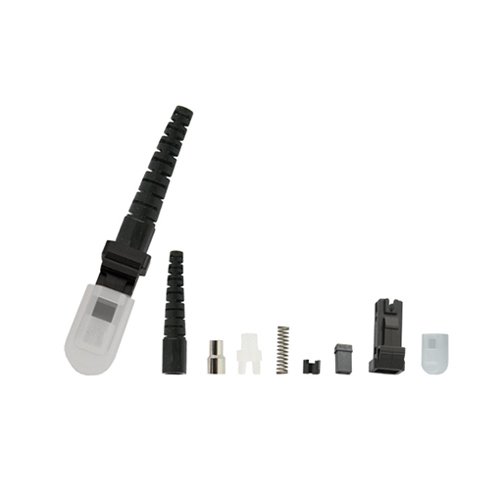- +1 (510) 365-3338
- +1 5103653338
- evan@commmesh.com
- +86 15274842581
An MTRJ connector joins two optical fibers. You can use it in data centers. This connector has 2 fiber connections. It uses a 5-millimeter ferrule. This component features 2.45 x 4.4-millimeter dimensions. Moreover, it is a small form-factor connector.
The item features reduced jacketing, fitting into tight spaces. It features number 6-32 screw mounting. It has a 4.5-millimeter body. This uses 125 µm fibers. Additionally, the part contains a thermoplastic housing which offers a durable solution. The connector presents a 9/125 structure.
The part provides a reliable connection. It features an operating wavelength of 1310 nanometers. This device supports 1000 mating cycles. The part maintains polarity through keyed housings.
The connector’s operating temperature range is -40 to 75 degrees Celsius. It has a 0.5dB insertion loss. This connector has a push-pull mechanism.
An MTRJ connector utilizes convex polished surfaces. You see end-face geometry controlled within 25 nanometers. It has a 10-millimeter radius. Apex offset is below 30 micrometers. Fiber undercut is minimized to 35 nanometers, ensuring minimal signal disruption. This connector ensure precise alignment.
This MTRJ connector’s body is injection-molded. It is made from polybutylene terephthalate. A 30% glass fiber reinforced composite provides strength. You find material modulus near 8 gigapascals. Thermal expansion is 2.3e-5 per degree Celsius. This connector’s housing resists deformation.
These devices exhibit modal bandwidth exceeding 2 gigahertz per kilometer. You will observe reflectance under -55 decibels. Attenuation variation is under 0.2 decibels across production lots. This connector provides link lengths beyond 550 meters. It guarantees stable data throughput.
The connector operates in environments from -40 to 85 degrees Celsius. It maintains performance at 93% relative humidity, non-condensing. Salt spray tests show minimal degradation after 500 hours. You can use it, as vibration tests confirm no resonance below 2 kilohertz.

| Feature | Specification | Material | Performance | Dimensions | Compliance |
| Fiber Count | 2 (Duplex) | Zirconia Ceramic Ferrule | Insertion Loss: ≤0.75 dB (Typ. 0.3dB) | 4.5 x 10.5 x 22 mm | TIA/EIA-604-12 |
| Ferrule Size | 1.25 mm | PPS/PEI Housing | Return Loss: ≥20 dB (MM), ≥50 dB (SM) | Ferrule Bore: 125-127 µm | IEC 61754-6 |
| Cable Type | 9/125 µm (SM), 50/125, 62.5/125 µm (MM) | TPE/Rubber Strain Relief Boot | Mating Durability: >500 Cycles | Cable Diameter: 3.0 mm | RoHS |
| Wavelength | 850 nm, 1300 nm, 1310nm, 1550 nm | Aluminum/Brass Crimp Sleeve | Temp. Range: -40°C to +85°C | Spring Force: 2.5N – 7.8N | GR-326-CORE |
| Housing Type | Push-Pull Latch | Stainless Steel/Music Wire Spring | Tensile Strength: 1500 PSI | Boot Length: ~20 mm | ISO/IEC 11801 |
| Polish Type | UPC, APC | Precision Molded Thermoplastic | Vibration Resistance: 10-55 Hz | Connector Body: ~10 mm | REACH |
| Mounting | Panel Mount, Free Hanging | Metal Alloy | Shock Resistance: 500g | Adapter: ~25 mm | UL94 |
This MTRJ connector ferrule uses yttria-stabilized tetragonal zirconia polycrystal. Its Vickers hardness measures 1200. Fracture toughness is 6 megapascals. The material's density is 6.05 grams per cubic centimeter. You will find the grain structure is refined below 0.6 micrometers.
These connectors feature a liquid crystal polymer housing. This material exhibits a 150-megapascal tensile strength. Water absorption is under 0.02%. Its dielectric constant measures 3.2 at 1 megahertz. You will find its flammability rating is UL94 V-0, ensuring safety.
The spring consists of a beryllium copper alloy within. Its yield strength is 1100 megapascals. It has a modulus of the spring of 130 gigapascals. Fatigue limits exceed 400 megapascals. You get a component that works well in small spaces. It provides force.
This connector uses a specialized epoxy. It features a modified bisphenol-A resin. The curing agent is an aliphatic amine. Its shear strength exceeds 25 megapascals after curing. You find glass transition happens at 125 degrees Celsius. It bonds well.
Quick Contact
To save your time, please contact us quickly via the form below to get an instant quote.
